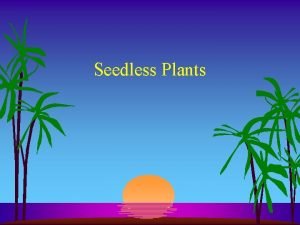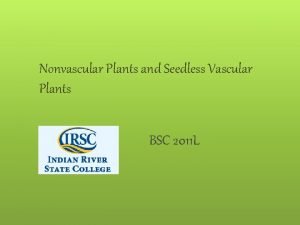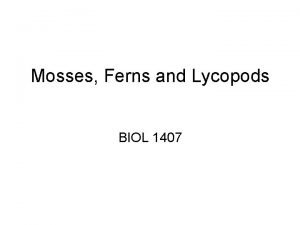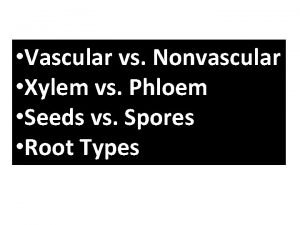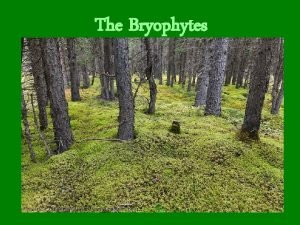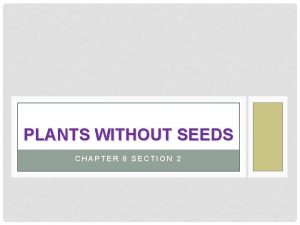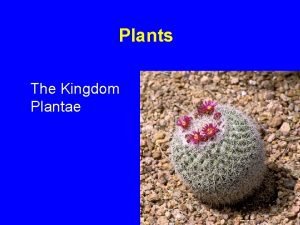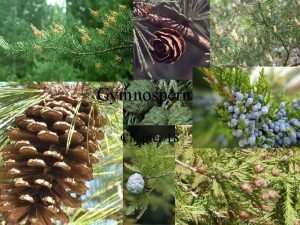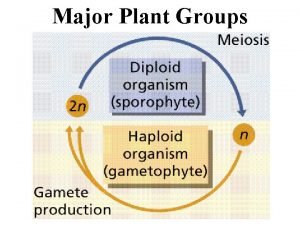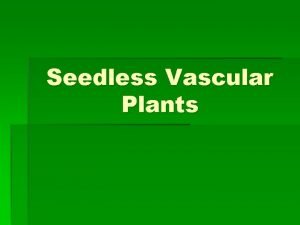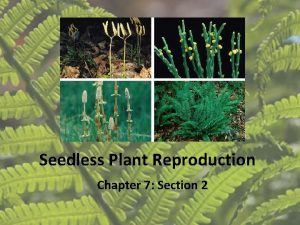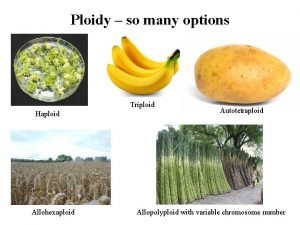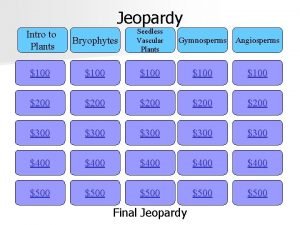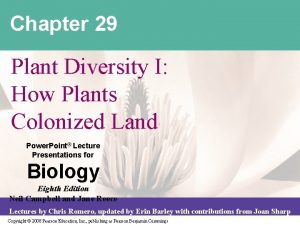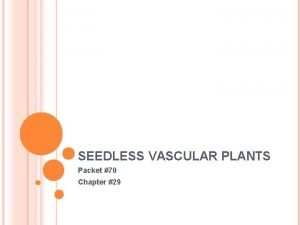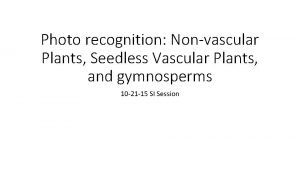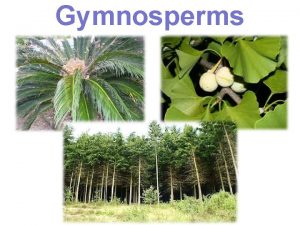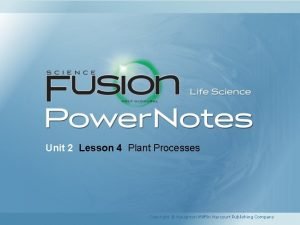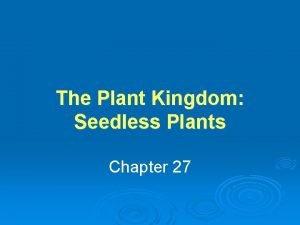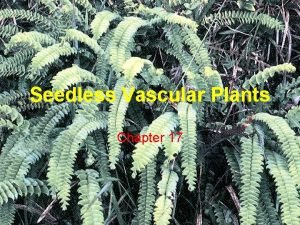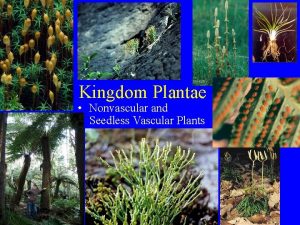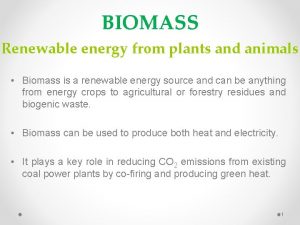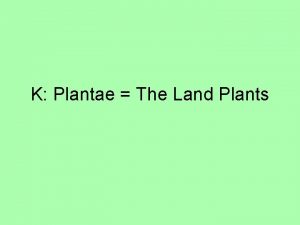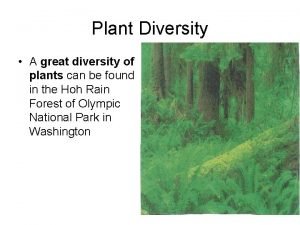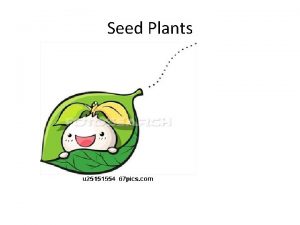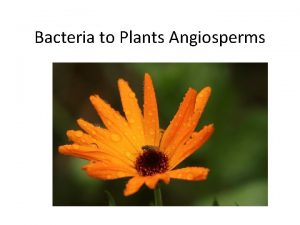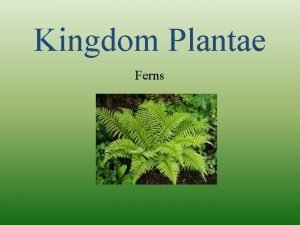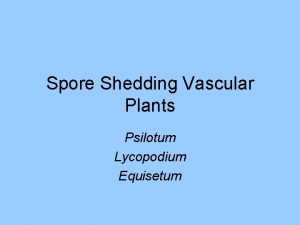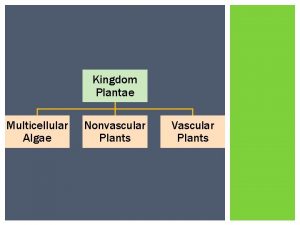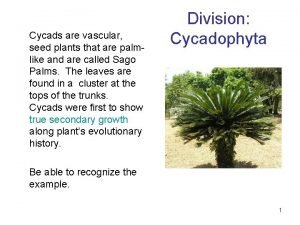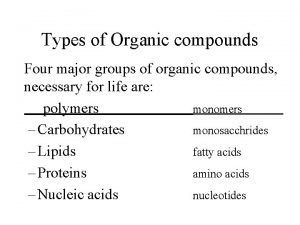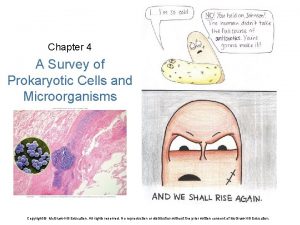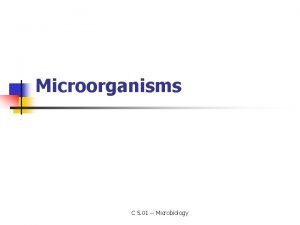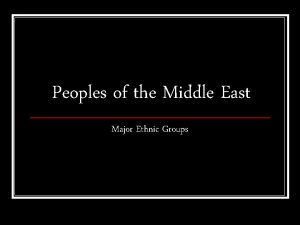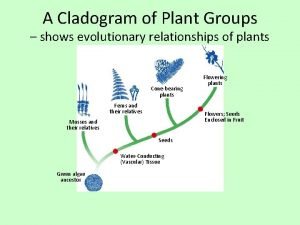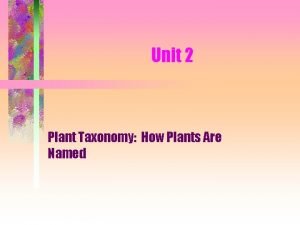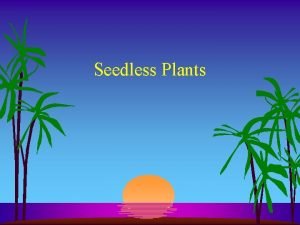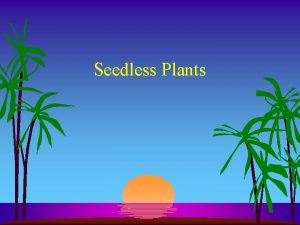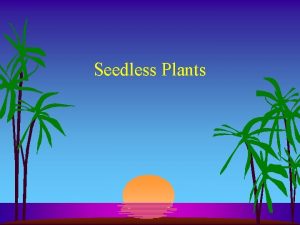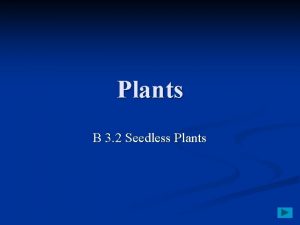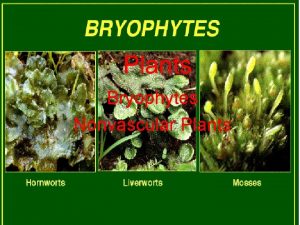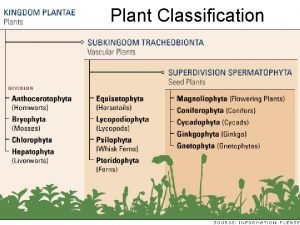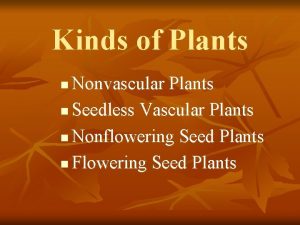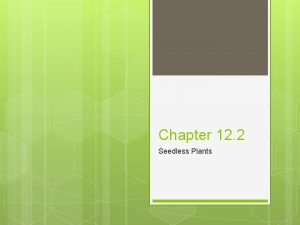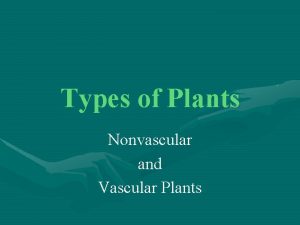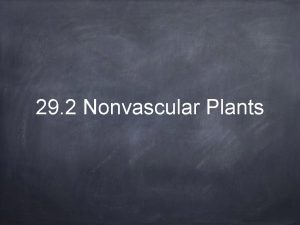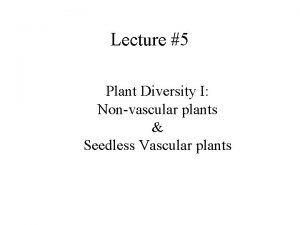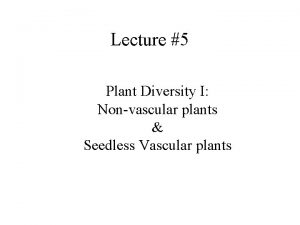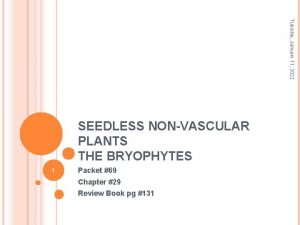Major Plant Groups Group 1 Seedless Nonvascular Plants














































- Slides: 46

Major Plant Groups

Group 1: Seedless, Nonvascular Plants • Live in moist environments – Need water to reproduce • Grow low to ground (nonvascular) • Lack true leaves • Common pioneer species • Gametophyte most common (dominant) • Ex: Mosses, liverworts, hornworts

Group 2: Seedless, Vascular Plants • Vascular system – Taller growth – Nutrient transportation • Live in moist environments – swimming sperm • Has primitive roots called rhizoids • Gametophyte stage – Called Prothallus – Creates egg and sperm • Sporophyte stage – Leaves called “Fronds” – Spores created on underside in clusters called “sori” • Ex: Ferns, Club mosses, Horsetails

Fern Frond

Underside of frond

Group 3: Seed producing, Vascular Plants • Type 1: Gymnosperms • Needle-like leaves (reduces water loss) • Common to lumber industry • Seeds enclosed in cones – Male cones: produce pollen (sperm) – Female cones: produce eggs • Zygote hardens into seed (protected inside cones) • Ex: Evergreen, Pine, Redwood, Cedar

Gymnosperm Life Cycle 1) Male and female seed cones grow on adult sporophytes Let’s zoom into the cones of this sporophyte tree. Male cones Female cone

2) Pollen (male gametophyte) released from the male seed cones. Female eggs become fertilized Zygote created inside the female cones Male cones make pollen Female cones make eggs zygo egg te

seed 3) Seeds begin to harden inside the female cones

4) Seeds often spread by wind “wing” helps seeds spread greater distance

5) Seed will land ground

6) Seedling grows into (sporophyte)…the cycle repeats ground

Seed Advantages • 1) Seed plants don’t depend on water to reproduce – Pollen spread by wind animals • 2) Embryo has…. – Nourishment: Nutrients inside feed embryo – Protection: Hard shell • 3) Seeds allow for dispersal – Carried by wind, water, animals Some seeds have “wings” Some seeds are carried by wind Some seeds are carried by animals

Helicopter seeds http: //www. youtube. com/watch? v=0 l 3 okbz. Cz. FE

Group 4: Flowering Plants • Angiosperms (flowering plants) • Flower = reproductive structure – Attract animals to help spread pollen – Forms fruit to protect and spread seeds • Seeds – Grow inside the fruit – Inside the seed 1. Embryo 2. Food supply

Seed Dispersal • Fruit brightly colored – Attracts animals • Seeds pass through animals digestive system • Seeds pooped in a new area to grow Fruit seeds in fox poop

Angiosperm Groups • 2 groups: Based on seed type • Cotyledon: embryonic leaf • Two Categories: – Monocots: embryo with 1 seed leaf – Dicots: embryo with 2 seed leaves

Monocots vs. Dicots ehh Know this one

Apple Tree: Monocot or Dicot? 2 3 1 Net-like veins 4 5

Monocot or Dicot? 2 3 1 4 6 5

Monocot or Dicot?

Monocot or Dicot?

Monocot or Dicot? Veins run parallel

Monocot or Dicot? Veins run parallel

Monocot or Dicot? Veins branch outward

Angiosperm Life Spans • Three Life Span Types: • 1) Annuals – Seed grows… – Produce flowers & seeds… – Die • 2) Biennials – 1 st year: • Seed grows and stores food – 2 nd year: • grows more… • makes flowers & seeds… • dies • 3) Perennials – Live for more than 2 years – May take decades to grow fruit

Flowers petals sepals • Reproductive structure of angiosperms • Sepals – outer ring of leaves – protection • Petals – Inner ring of leaves – Brightly colored to attract pollinators • Male and female organs found inside

Tulip Pistil and Stamen female

Lily Pistil and Stamen female

Pistil and Stamen female

Pistil and Stamen female

Flowers • Male Stamen – Anther: produces pollen (sperm) • Female Carpel/Pistil – Inner most part – Ovary: within the base • Contains eggs • Grows into fruit when fertilized – Stigma: sticky tip, collects pollen

Self-Pollination (own pollen fertilizes own egg) . . .

Cross-Pollination (pollen of one, fertilizes egg of another) . . .

Angiosperm Life Cycle 1) Pollen sticks to animal or Here an apple tree…. lets released intoiswind zoom into an individual flower. . .

Angiosperm Life Cycle 1) Pollen sticks to animal or released into wind 2) Insect comes across another flower and spreads the pollen to stigma . . .

Angiosperm Life Cycle 1) Pollen sticks to animal or released into wind 2) Insect comes across another flower and spreads the pollen to stigma 3) Pollen tube grows towards ovary .

Angiosperm Life Cycle 1) Pollen sticks to animal or released into wind 2) Insect comes across another flower and spreads the pollen to stigma 3) Pollen tube grows towards ovary 4) Nucleus travels down pollen tube to fertilize egg .

Angiosperm Life Cycle 1) Pollen sticks to animal or released into wind 2) Insect comes across another flower and spreads the pollen to stigma 3) Pollen tube grows towards ovary 4) Nucleus travels down pollen tube to fertilize egg 5) Zygote hardens into seed…flower starts to die ovary . . seed

Angiosperm Life Cycle 1) Pollen sticks to animal or released into wind 2) Insect comes across another flower and spreads the pollen to stigma 3) Pollen tube grows towards ovary 4) Nucleus travels down pollen tube to fertilize egg 5) Zygote hardens into seed…flower starts to die 6) Ovary grows into a fruit (seeds insides) ovary

Angiosperm Life Cycle 1) Pollen sticks to animal or released into wind 2) Insect comes across another flower and spreads the pollen to stigma 3) Pollen tube grows towards ovary 4) Nucleus travels down pollen tube to fertilize egg 5) Zygote hardens into seed…flower starts to die 6) Ovary grows into a fruit (seeds insides)

Angiosperm Life Cycle 1) Pollen sticks to animal or released into wind 2) Insect comes across another flower and spreads the pollen to stigma 3) Pollen tube grows towards ovary 4) Nucleus travels down pollen tube to fertilize egg 5) Zygote hardens into seed…flower starts to die 6) Ovary grows into a fruit (seeds insides)

A few hours later… seed

Seedling begins to grow… seed

Years later….

HW: Bring a flower and leaf to school. One with distinct male and female parts.
 Seedless vascular plants
Seedless vascular plants Multicellular dependent embryos
Multicellular dependent embryos Reproduce by spores
Reproduce by spores Vascular vs nonvascular plants
Vascular vs nonvascular plants Non vascular plant
Non vascular plant Lycopods
Lycopods Vascular vs nonvascular
Vascular vs nonvascular Nonvascular plants phylum name
Nonvascular plants phylum name Chapter 8
Chapter 8 Common characteristics of plants
Common characteristics of plants Ginkophyta
Ginkophyta Major plant groups
Major plant groups Xylem and phloem
Xylem and phloem How seedless plants reproduce
How seedless plants reproduce Wheat
Wheat Which seedless plants have been used to treat bee stings
Which seedless plants have been used to treat bee stings Are angiosperms seedless vascular plants
Are angiosperms seedless vascular plants Chapter 29 plant diversity
Chapter 29 plant diversity Sprophytes
Sprophytes Image of a cat
Image of a cat Advantages of gymnosperms
Advantages of gymnosperms Unit 2 lesson 12 flowering plants
Unit 2 lesson 12 flowering plants The are seedless vascular plants with hollow jointed stems.
The are seedless vascular plants with hollow jointed stems. Phyla of seedless vascular plants
Phyla of seedless vascular plants Are cell walls prokaryotic or eukaryotic
Are cell walls prokaryotic or eukaryotic Isoetes
Isoetes Why are seedless plants important
Why are seedless plants important Advantages of biomass
Advantages of biomass Heterosporous
Heterosporous How are ethnic groups and religious groups related
How are ethnic groups and religious groups related Plant evolution cladogram
Plant evolution cladogram Kingdom eukariotik
Kingdom eukariotik Seed plants are divided into
Seed plants are divided into Is a gerber daisy vascular or nonvascular
Is a gerber daisy vascular or nonvascular Coniferophyta vascular or nonvascular
Coniferophyta vascular or nonvascular Kingdom of ferns
Kingdom of ferns Psilotum photosynthesis
Psilotum photosynthesis Is algae vascular or nonvascular
Is algae vascular or nonvascular Pinus staminate cone labeled
Pinus staminate cone labeled Characteristics of flowering and non flowering plants
Characteristics of flowering and non flowering plants C3 plants vs c4 plants
C3 plants vs c4 plants Four types of organic molecules
Four types of organic molecules Major taxonomic groups
Major taxonomic groups Major groups of microorganisms
Major groups of microorganisms What are the major ethnic groups in the middle east
What are the major ethnic groups in the middle east Plant cladogram
Plant cladogram How plants are named
How plants are named

